newsltr
NSPCB Newsletter - January - February - March - Winter 2001
Sunday March 25, 2001 at 1:00 P.M. at the Plymouth Church. This meeting is scheduled for the Plymouth Church, 87 Edgell Road Framingham, Mass. On the East side of Edgell Road (Route 30 in Framingham, Mass.) This location is just North with Route 9. It is located on the right hand side or the East side as you are traveling North from Route 9. There is always plenty of parking space for this meeting. The Program: Covered Bridges taken in Europe in 1988. These slides were taken by Beatrice and George Chaplin. This should prove to be a very interesting program.
Sunday April 22, 2001 at 1:00 P. M. at the Plymouth Church. See directions above. The Program: will be Covered Bridges of the South and will be shown by Joseph Cohen. Joseph has traveled many miles in search of Covered Bridges and these should prove to be very interesting.
As usual there will be no meeting in May.
Plans for the June and July meetings have not been formulated at this time. I am asking that if anyone has a slide presentation or a program that the Society could use at one of the meetings, please let me know. My phone number and e-mail address are listed above. The August meeting is usually a picnic meeting held at the site of the Archives in Westminster, Vermont. This year it falls on the 26th of August.
An after thought: Maybe we could have a Post Card sale and trade. Post cards go very well with many of the members. Pauline Prideaux has many of the Society Post Cards available for sale.

By Bob and Trish Kane
Delaware County:
‡ Hamden Covered Bridge - NY 32-13-03 Exciting News!!! The Hamden Covered Bridge is back home again! On November 13, 2000 the bridge was placed back over the west branch of the Delaware River. Gary Van Buiten, noted building mover from Oxford, NY, was given the honor of pulling the bridge home with a truck and crane. Everything went smoothly and it was an exiting day for the residents of Hamden and Delaware County Officials. William Kline completed his part of the project and has now left the work site.
The County recently removed the center support and the steel I-beams from under the bridge. They will soon be placing oak running planks on the deck to help protect it against illegal snow mobile track spikes. Currently, concrete barriers are being used as temporary restraints. The shale around the bridge is frozen solid so it doesn't look like the bridge will be opened to traffic now until spring. Gravel and asphalt will then be used and timber guide rails installed after the asphalt it laid. The bridge is beautiful now that it has been restored and the folks in Hamden are very proud and excited about their bridge. Plans are currently under way for a dedication ceremony with a tentative date set for July 28, 2001. Be sure to mark your calendars and plan on attending this great celebration. More details will follow in the next issue of this newsletter.
‡ Fitches Covered Bridge - NY 32-13-02 The restoration work on this
bridge will remain on site and supported by a steel beam false work. The corners of the
abutments at the ends of the trusses will be rebuilt to accommodate the new trusses, which will
be 8 feet longer. It is being lengthened to restore the bridge back to its original construction
length. When moved from Delhi to this site in the late 1800's, it was shortened. The flared
configuration of the ends of the trusses placed quite a bit of overload on them, which led to the
addition of the steel plates in the 1970's in an attempt to support the bridge. Restoring it back to
its original length will make the bridge much stronger. The trusses will be rebuilt with all sawn
timber (Douglas fir) and all wooden trunnels. The floor beams will be gluelam and the deck will
be longitudinal timber planks with running planks on top.
At this time it is not certain how long
the Fitches Bridge will be out of service, but probably most of 2001. It will be exciting to watch
the restoration progress on the last covered bridge to be restored in Delaware County.
Saratoga County:
‡ Copeland Bridge - NY 32-46-01 Progress has been made and the Historical Society, as well as the residents of Edinburg, are really exerted! They are very happy with the work that has been done to date by Darrin Tracy of West Branch, Inc. Before inclement weather set in, they were able to complete the stone masonry work on the abutments and begin work on the inside of the roof They also began reattaching the sidewalls to the new beams. Work will commence again in the spring.
Town Highway Supervisor, Marvin Wilson, was wonderful with his assistance on this project. Marvin and some friends cut down trees on the upper hill behind the bridge. He then took his chain saw and stripped and cut these trees into the new main beams for the bridge!
The Historical Society has received $25,000 from the Adirondack North Country Enhancement Program on behalf of Governor Pataki. Senator Hugh Farley has contributed $18,000 to date from the NYS Office of Parks Recreation and Historic Preservation. Money continues to come in on the Buy-a-Share of History Campaign and to date they have $31,000 (in hand) toward their goal of $125,000. It is so wonderful to see a community as well as county and state officials, all pulling together in support of restoring this little Covered Bridge. For more information on what you can do to help, contact the Edinburg Historical Society, Ms. Marie Penino, 7 Lakeside Drive, Edinburg, NY 12134 or call her at (518) 863-8871. Soon, we will be celebrating the dedication of the Copeland Covered Bridge. It is scheduled for completion in June 2001.
Sullivan County:
‡ Beaverkill Covered Bridge - NY 32-53-02 While there is no news regarding the State's projected purchase of the Beaverkill Covered Bridge, there has been a major effort by the New York State Department of Environmental Conservation this summer and fall to beautify the campgrounds around the bridge. Older, matured maples have been cut down and a variety of elms, maples and evergreens have been planted alongside a newly re-built stone stream bank. Theodore Gordon Flyfishers have erected an iron historical sign just below the bridge noting the Beaverkill Bridge pool's value as a significant location in the lore of American fly-fishing. Along with newly graded and seeded lawn, it should make the bridge's background all the more beautiful.
Other news: DeLorme Atlas Project - Maps identifying the location of New York's Covered Bridges will soon be submitted to DeLorme Atlas Company for inclusion in their next edition of the New York atlas. Working with the folks at DeLorme, we have determined that the following states have covered bridges, but their locations are not indicated on their maps: California, Connecticut, Delaware, Georgia, Illinois, Maryland, Massachusetts, Michigan, Minnesota, Missouri, New Jersey, New York, North Carolina, Oregon, Rhode Island, South Carolina, Tennessee, Texas, Virginia, Washington, and Wisconsin. Contact will be made with known Covered Bridge organizations in these states inviting them to participate in this endeavor. If you are interested in getting your state's covered bridges listed, contact: Bob and Trish Kane at 167 Williams Rd., Sherburne, New York or e-mail them at: bobpat68@clarityconnect.com and they will be happy to tell you how to go about doing so. It is really very easy and is a tremendous help to those who enjoy discovering and photographing these wonderful structures.
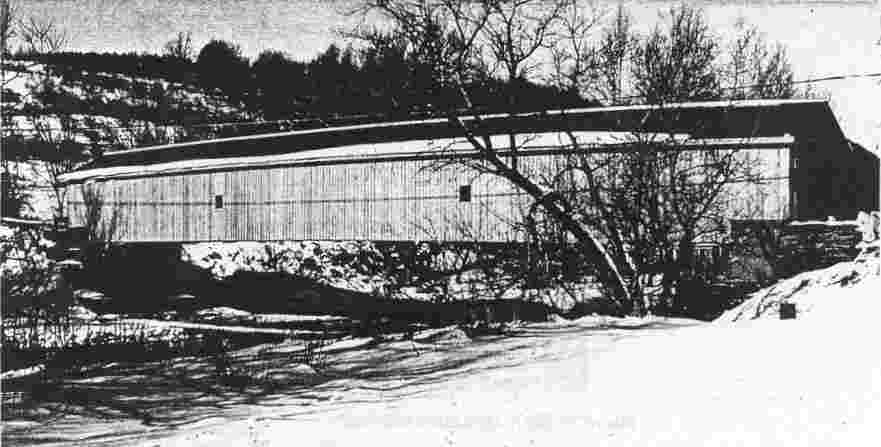

Bridging the Bluegrass State (KY)
By Melissa Jurgensen
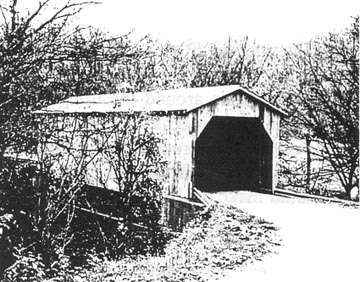
The Dover Bridge [17-81-01] in Manson County, has recently had a facelift. It received new
siding, a new roof, and some new rafters. The graffiti on the trusses has been painted over, and
the steel I-beam underneath the bridge has been painted green.
The trusses of the Coleville Bridge
[17-09-03] in Bourban County have been set up at the bridge site. The bridge is expected to be
completed sometime after the first of the year. Work on the bridge has been delayed due to bad
weather, but it is expected to begin again soon. It is believed that after the construction is
complete the siding will be left natural, instead of painted like before.
The Walcott Bridge (17-12-01] in
Bracken County is 'the next bridge scheduled to be restored. Currently it is in storage, and will be
moved to a more stable position up stream.
Dover Bridge, Mason County Kentucky (17-81-01) photo © Melissa Jurgensen

Ohio's McColly Bridge [35-46-01]
By Brian McKee
On Saturday afternoon, November 18th, I visited the McColly Bridge 35-46-01 in Logan
County, Ohio and found it to be open to the public again. The restored bridge looks very nice,
and quite different from the previous appearance when it was painted white.
The steel framework under it isn't visible
unless you walk underneath the bridge. Most of the original structure is still there.
An error occurred in the last Newsletter,
relating that the Amos Schwartz Company had been replaced by the Righter Company. This was
in error. After the Amos Schwartz Co., who was awarded the contract, was finished with their
portion of the contract, it sublet the Truss work to the Righter Company, as qualified timber truss
framers. The Schwartz Co. was not removed from the job as stated in the last
Newsletter.
From The Vindicator, Youngstown
Ohio, July 2, 2000 - [35-15-O5] Submitted by Thomas WaIscak. The Centennial or
Teegarden Bridge is a fine example of creativity and workmanship. The old bridge doesn't look
like much these days. Planks are missing from its sides and vandals have marred it with graffiti.
Because of its historical and scenic value. It has prompted efforts to have the bridge repaired and
placed on the National Register of Historic Places. - Federal authorities are reviewing the
historical significance of the structure, explained Tom Wolf, public education manager for the
Ohio Historical Preservation Office. - The bridge was Built in 1876 by Jeremiah Mounts, the 67
foot long bridge crosses the Middle fork of Little Beaver Creek. -The bridge, now owned by
Columbiana County, is close to a scenic Salem city Park known as Eagleton's Glen. - The
structure was used until 1992, when it was bypassed and a modern bridge was installed on
Teegarden Road. - It was dubbed the Centennial Bridge in honor of the nation's 100th
birthday.
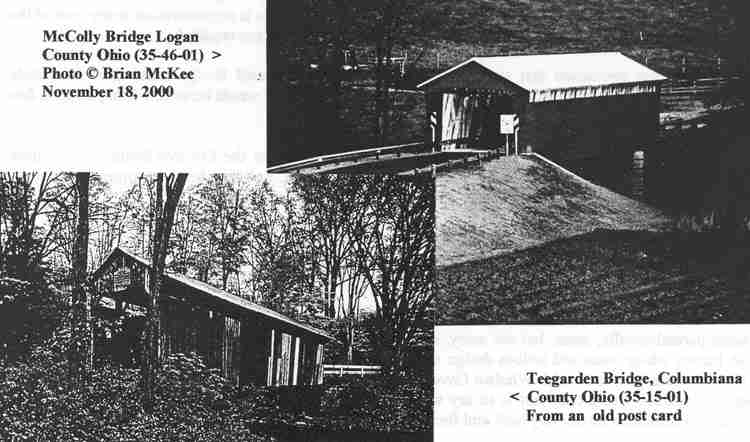

Topics, winter, 2001:
Dear Fellow Members, Greetings!
I trust that all of you had happy holidays; I know that I certainly did. In fact, given half a
chance, I should be willing to recommence them immediately, so much did I enjoy them.
Unfortunately, the days in question come around but once a year, and so I must content myself
with waiting, something which, by the way, I do not do very well. Once again I guess, it is a
matter of "grin and bear it".
Speaking about `grinning and bearing it',
we must alas all of us, do some of that respecting the now demolished Fuller Covered Bridge in
Montgomery, Vermont.
As you will probably all remember, in
the Fall President's Message I was discussing Covered-Bridge preservation here in Vermont, and
was deploring one of the latest developments in this State; namely, preservation through
demolition. You will all doubtless recall too the publicity slogan I suggested for the Vermont
Agency of Transportation; "Demolish today, so that future generations can enjoy the treasures of
the past".
(Parenthetically, word has yet to reach
me as to whatever that Agency shall adopt my motto. In this particular case, however, please
don't ask me why, I seriously doubt silence gives anything like consent. What do you think?!)
My point in that missive, and none of
you I'm sure was misled by my heavy irony, was that one cannot be said to have saved when one
has in fact removed and destroyed, particularly if; as is my contention in the case of the Fuller
Covered Bridge, total removal of the span in question was absolutely not
required.
Before addressing my contention that
some, at least, of the Fuller Covered Bridge could have been truly preserved, not removed and
thus lost both to us and to future generations, it would be well, I think, to say a few words about
Covered-Bridge Replicas.
Covered-Bridge Replicas have in my
opinion an important role to play in the Covered-Bridge Preservation Movement, but not, of
course, as substitutes for the older spans which, had they but been properly restored, could have
continued to serve for many years to come, perhaps for many centuries.
A properly executed replica, and here of
course, with all due apologies to the English Language, I mean a more or less exact one,
ought to be the invariable response of an outraged public to any act of arson perpetrated against a
Covered Wooden Bridge, an act of arson that is, where, as a result of it, the bridge in question has
been lost.
(Once again parenthetically, some, but
not many, at least not of the survivors, Covered Wooden Bridges were built with trusses which
contained serious design errors and/or other insufficiencies. A famous example which comes
readily to mind is the Cornish Windsor Covered Bridge between Cornish, New Hampshire, and
Windsor, Vermont. Under dead load alone, that is to say with no traffic going over it, with not so
much as a single squirrel running through it on his way back and forth from Cornish to Windsor,
with no snow on the roof; and of course with no wind blowing, this structure was still over
stressed in the upper chords over the central pier by a factor of about 2.5 to 1.)
(Fortunately, of the many surviving
nineteenth and earlier twentieth century Covered Bridges, only a few have structural problems of
the sort which have been outlined above.)
(Should a span with inherent design
flaws fall victim to fire or flood, however, and should the decision have been made, in face of such
a loss, to replicate the ancient structure, then it would be well to consider addressing the design
flaws in question during the course of that span's replication. Sometimes the introduction of just
slightly larger timbers in crucial areas will be sufficient to turn the matter around; other times, a
slightly higher truss plus beefed up timbers might be required.)
(The important point to be remembered here is that in principal, we have been discussing,
and advocating, replicas, which term, strictly speaking, means reproducing a second time
around, an exact copy of some object, structure, painting or the like.)
(If in order to eliminate structural
insufficiencies from the truss one is attempting to reproduce, it were necessary to redesign that
truss radically, then of course one could no longer say one was replicating the original
structure. One would in fact be erecting a new one, whatever one might my one was doing.)
(To sum up, as a practical
matter, and in order, faced with some kind of disaster, to retrieve at least partially a span which
otherwise should be lost to us forever, minor changes to the design and even disposition of a
Covered-Bridge Truss ought to be tolerated in a well made replica of said truss.)
(Radical changes, however, are another
matter, as has already been indicated above.)
(If in order for a Covered-Bridge Truss
to be stable, and consequently free from the need for more or less constant repair, a significant
redesign of the truss in question were to prove necessary, then the introduction of a secondary
load-bearing structure, nail-laminated plank arch, arch brace, or inferior brace, built up in a
traditional manner, is the proper solution.)
(It should be noted that correctly
designed secondary load-bearing structures could always be removed, were one for the some
reason to want to do so. Once removed of course, the trusses of the span from which they had
been withdrawn would still be "exact replicas" of those of the lost bridge, and consequently,
would bear truthful witness to the techniques, materials, and structural notions of the builders of
the original span.)
(In light of the above discussion, it
ought to be abundantly clear to anyone with the wit to understand 1,2,3, that when the Cornish
Windsor Covered Bridge was most recently repaired -- its fifth major renovation by the
way, the first one having been carried out by James F. Tasker, himself! - a wrong direction was
taken: rather than building up two great pairs of nail-laminated plank arches, as was proposed by
Milton S. Graton at the time, the Trusses themselves were invaded - about a third of them was
simply removed and burned in a nearby field! -and redesigned. The present Cornish Windsor
Covered Bridge is therefore not the fourth span to have to have occupied the site, but
rather the fifth. It is a new bridge which just happens to contain many remnants of its immediate
predecessor, the span built by James Tasker. Tasker's bridge has alas gone a glimmering, as
indeed have so many other beautiful things which the collectivity either lacked the wit to
understand, or the will to preserve.)
Replicas of long gone Covered Bridges
also have their place.
The difficulty in reproducing long gone
structures, however, and not just bridges, is obvious: it is one of information.
In respect to bridges, what was the span
to be reproduced really like? What kind of trusses did it contain? How high were they, and out of
what materials were they made? What was the disposition of the upper and lower lateral bracing
systems? Did the span in question actually have a lower lateral bracing system - many of them did
not - and so on and so forth. Often there are photographs; far less frequently there are drawings,
but even given the existence of both of these, for long removed Covered Bridges there will
probably always be certain details which shall have to be invented or imagined. Yet despite the
fact that in any given instance, a Covered Bridge replica may prove to be partially inaccurate,
nevertheless, it is only through attempting to recreate something which has gone missing from our
lives, so to speak, that we can hope to retrieve a part of the past which would otherwise be lost
forever.
And besides, a well executed Covered
Bridge replica, one framed by a Master Bridgewright that is, even if inaccurate in some of its
detail, will still be a positive addition to any landscape!
Finally, there is an additional kind of
Covered Bridge "replica" which most definitely has legitimacy, though I admit that I am stretching
the meaning of the word "replica" a bit here; that is to say, new Covered Bridges at perhaps even
new locations which hold themselves up by means of any one of the traditional Covered Bridge
trusses, trusses of course which employ traditional materials -- no "glue-lam", no plastic, thank
you very much! -- and which have been built up in the traditional manner.
Such "replicas" can have several
purposes: 1) They can be part of a kind of museum wherein one might find all sorts of other
structures illustrating various construction techniques and architectural styles from different
periods. As such, both they and of course the other recreated structures, would be marvelous
teaching devices; 2) They can hold themselves up by means of traditional nineteenth century
Covered Bridge trusses, but traditional nineteenth century Covered-Bridge trusses of which there
are no longer any surviving examples. As such, they would provide all of us with an opportunity
to see how these truss types looked in three dimensions and life size, so to speak. Two extremely
important truss types which just cry out for replication come readily to mind: The Haupt truss, of
which there is now only one remaining example, as far as we know, and the example in question
does not contain arch braces, which devices, for spans of any length and designed to carry heavy
loads, were supposed to be made use of at least according to General Haupt, and any one of the
several Squire Whipple WOODEN bridge trusses mentioned by him in his pioneering 1847 work
on bridge construction and structural analysis; and 3) they can be erected by communities which
have decided, for whatever reason, that they should like to have a Covered Wooden Bridge in
their midst.
At the beginning of the present
discussion concerning replica Covered Bridges I stated that these structures had an important role
to play in the Covered Bridge Preservation Movement.
One aspect of their importance has yet
to be touched upon.
It is that the building of these structures
sometimes constitutes, and indeed could constitute in every instance, if only matters were
arranged properly, a significant training ground for our contemporary would-be Covered Wooden
Bridgewrights.
All too often is it the case that repairs to
our historic Covered Bridges are carried out in a deplorable fashion, more often than not by
general contractors who have little knowledge of and very little interest in the techniques and
materials of the nineteenth and early twentieth centuries.
Someone who has built a replica of an
original Covered Wooden Bridge, however, will have an entirely different perspective on the
subject. Such an individual, especially should he have been lucky enough to have had some expert
guidance during the course of his Covered-Bridge building apprenticeship, will be much more
likely to treat historic Covered Bridges with sensitivity, and with all due respect for the rather
exacting craft which produced them in the first place.
To be continued next time.
Sincerely, Your president, David W. Wright

Evelyn H. Thomas
1910 - 2000
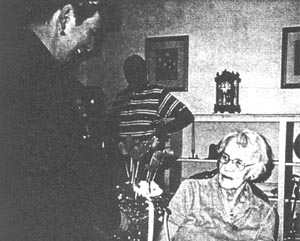
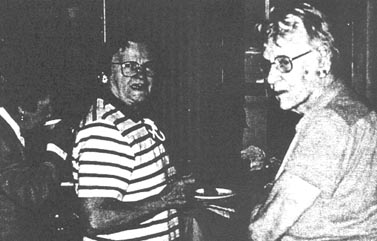
Left to right Pauline Prideaux, David Topham. Evelyn Thomas, Edith Hoxie June Roy, Evelyn Thomas.
It is with great sadness that one of the more prominent member of the National Society has
crossed the bridge. Evelyn passed away on October 31, 2000. Evelyn was a 1929 graduate of
Foxboro High School, a 1930 Graduate of Cushing Academy and a 1934 graduate of Brown
University. She also worked for many years as statistician at the Foxboro Company, retiring in
1977.
A long time Girl Scout leader, she had
served as co-director of the former Rocky Knoll Girl Scout Day Camp in Foxboro. She was also a
parishioner at Bethany Congregational Church.
Evelyn was a member of many covered
bridge organizations throughout the country. However her principle love was the National
Society. Evelyn worked tirelessly towards the cause of preserving Covered Bridges. Her and
Edward were one of the prime movers pushing for the cause of having a special fund for the
preservation of Covered Bridges. Henceforth the Harold Eastman Memorial Find began and today
it has been instrumental in aiding many needy bridges.
After Edward's death The Edward
Thomas Memorial Archive Fund was established. Evelyn's name will be added to this fund. This
fund is used to preserve covered bridge memorabilia. Foremost is the Collection of Richard
Sanders Allen, Oscar Lane, Harold Eastman, Barbara Brainerd, Joseph Conwill and many others.
Anyone wishing to contribute in her memory can do so by sending their contribution to David
Topham, Treasurer, 45 Village Way No. 50, Rockport, Maine. 04856-3805.
It is not over yet!
The material accumulated by Evelyn and the National Archives were stored in Foxboro, in various
locations. The problem was to gather the material and to redistribute the material so that it would
do the Society the greatest good for it's preservation.
On November 28, 2000 Col. Wilbar
Hoxie and myself rented a 14 foot U-haul truck and picked up all of the collected material
involved. It is now in storage at U-haul here in Manchester, NH. Col. Hoxie was a great help as
all of the items were hauled out by Wilbar and myself and the use of a two wheel hand truck
For those who are not familiar with the
Archives, a great amount of material was collected and catalogued by Oscar Lane many years
ago. Upon Oscar's passing the material was placed in storage but the building was made of wood
and was dangerous. Sometime after Evelyn gathered the material and had it stored in the Foxboro
Library. There were 6 book cases and about 180 loose leaf binders.
The retrieving of this material took the
better part of a day just to gather and return to Manchester. When I returned home I parked the
truck and waited until the next day to unload. I was thoroughly fatigued by that time. It took me a
couple of months to recuperate from this adventure, in fact I am still recuperating.
The loose leaf binders and the
photographs will end up in Rangely, Maine with Joseph Conwill. The Books will be brought to
the Archives in Westminster, VT. The Post cards that are for sale to Pauline and Don Prideaux.
The Society collection of Post cards will remain with me for the time being.
What to do with the slides! There are so
many slides it is impossible to accurately estimate the number. I would say that there is at least 80
or 90 thousand slides. This is a very wild guess there may be twice this number. Between the
Society Archive slides (14 metal boxes) that are sorted, and 20 boxes of Evelyn's own collection
all ready sorted would make the total here alone about 34 thousand. If anyone in the society has a
good idea as how to handle the slides, I would greatly like to hear from them.
I have been sorting out much of the
material that Evelyn had in her apartment and her spare room at the Doolittle Home, and as I
stated before It is not over yet.
Why was it done?
It had to be done! Evelyn was a friend to many people and she was a friend to all who had
anything to do with covered bridges. I believe we have the biggest collection of original negatives
and photographs of covered bridges anywhere in the United States. This tradition must keep
going. We were very fortunate to have Evelyn beef up the money in the Archive Fund. This
money is gaining interest every year. Hopefully someday the society will be able to supply copies
to interested parties. Each and every original is being preserved in archival material for its
preservation.
File Cleaning -- PENNSYLVANIA
Bloomsburg From the Daily Sun October 27, 2000 - Grant awarded to study repairs for covered
bridge. The federal Highway Administration is awarding a $100,000 grant to study repairs and
improvements to the Patterson Covered Bridge [38-19-26] in Columbia County. Preliminary
engineering is needed because formal design studies have not been done for the bridge.
The proposed project includes painting;
repair or replacement of truss members, timber deck and timber members; modification of bridge
portal; abutment repairs and backfilling of a scour hole; and installation of a "headache bars" and
timber curbing to protect the trusses from damage from vehicles.
WEARING OF THE GREEN - The
Sam Wagner covered bridge (38-47-01*49-11) over Chillisquaque Creek, east of Potts Grove,
has been decorated for the Holidays with a wreath made of hemlock branches from the William
Bitner Jr. Farm, gathered by his son Frederick. Richard Donovan and Linda Geyer made the
wreath at Mary Clewell's home. It was hung by the Potts Grove Fire Company truck.
From the Patriot-News December 5,
2000 Sent in by Richard Donovan. - Fire severely damaged Dauphine County's only surviving
covered bridge late Sunday and state police are investigating whether it was arson. - Flames were
leaping from the Henniger Farm Bridge [38-22-11] in Washington Township. The blaze damaged
one or two of the bridge's main beams and about half of one side. It's a nice covered bridge - the
only one in Dauphine County, so you can be proud of that." Said Tom Welker, of the Reliance
Hose Company. "The bridge was "pretty severely damaged" Welker said, but he believes "it could
be repaired."
From The Tribune Review, Dec. 12,
2000. Sent in by Richard Donovan. Bells Mill Bridge [38-65-01] in Westmoreland County was
damaged between December 9 and 11, 2000. This is the only covered bridge located on a public
road in Westmoreland County. The damage will be repaired. Repairs also will be made next year
to a damaged concrete and wooden support located at one of the entrances to the bridge. Those
damages appear to be the result of an accident.
From the Sentinel Reporter Nov 29,
2000, sent in by Richard Donovan. Perry County officials are accepting bids for the repair of 13
bridges. Bids sought for 8 covered spans and five others. Among the projects is repair of
vandalism of Rice's Bridge (38-50-10) over Shermans Creek near Landisburg. Other covered
bridges set for repair are; Fleisher's(38-50-17), Dellville (38-50-16),Wagoner's (38-50-15),
Kochendefer (38-50-09), Enslow (38-50-14), Mount Pleasant (38-50-12), New Germantown
(38-50-11). The article features a photo of the Dellville Bridge.
WEST VIRGINIA - From Jacqueline
Styles - The Hems Mill Bridge (48-13-01) near Lewisburg was dismantled and the stonework
being repaired/replaced. The Gentleman who we met was personally involved, mentioned that it
would probably be back in place in six months, said Mrs. Styles. See photo of Hokes Mill Bridge
next page.
NEW HAMPSHIRE From Christine
Ellsworth - Foster's Citizen, Oct 29, 2000 - The Cilleyville Bog Bridge (29-07-01) is now stable
but it needs plenty of work. The town of Andover established the Cilleyville-Bog Bridge
Restoration Fund in 1998. The goal is to raise $150,000 to restore the bridge and to create an
endowment for its future use. The article also speaks of several other covered bridges in the
area.
From David Topham - Swanzey, NH. -
Historic covered bridge on road to repair. After seven years of fund-raising the selectman of
Swanzey have awarded the contract for the rebuilding of the Slate Bridge to Wright Construction
of Mount Holly, Vermont. The original bridge was built in 1862 for $1,850. The new bridge will
cost $836,000. A temporary steel bridge is in use.
From Christine Ellsworth - Laconia
paper -Covered Bridge Damaged In Mishap - Swanzey - A historic Bridge was damaged in a
weekend crash. The town's road agent said the damage to Carleton was so extensive that they had
to close it. Police said that a Swanzey man was towing a large piece of tree digging equipment
that hit the bridge supports.
GEORGIA From Al Cummings -
Athens Daily News Dec. 20,2000 - A tradition 28 years ago by Al Cummings with the Christmas
lighting of the Elder's Mill Covered Bridge (10-108-01) in Farmington, Oconee County Georgia.
It is a single span 75 foot Town Lattice design bridge. However the article says "that either the
bridge is getting higher or I'm getting older. Take your choice" referring to Al Cummings. Cindy
Grady decorated the bridge last year and is doing it again this year. It shows a large photo of the
Elder's Mill Covered Bridge fully lighted for the holiday. Good Job Al
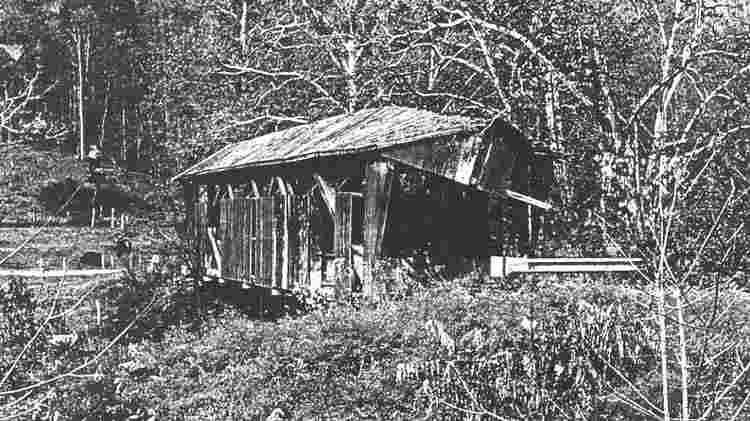
This is what Hokes Mill Bridge Greenbrier, County West Virginia (48-13-02) looked like on October 23, 2000. taken by Mrs. Jaqueline Styles of New York State. Mrs. Styles husband stated "I do not think that it will make many more winters" See related story in File Cleaning.
N.S.P.C.B. Safari 2000, Ashtabula County, Ohio
Forty-one people and friends from 13
States met at the Comfort Inn in Austinburg, Ohio Friday, September 8~' for a Safari led by
Minnie and Bill Galler to see the 16 covered bridges in Ashtabula County.
Friday evening, after getting instructions
for departure Saturday, we were entertained by George Eysenbach showing his slides of the
Columbia-Montour Safari last year.
Betty Morrison, Executive Director of
the Ashtabula County Covered Bridge Festival, rode in car #1 with the Gallers where she not only
kept us on track but also with her bubbly personality gave us many stories of the bridges.
Our first stop on Saturday was not at a
bridge but at the site where Ashtabula County Engineer, John Smolen plans to build a covered
bridge 90 ft. above the Ashtabula River. It will be 600 ft. long making it the longest CB in the U.
S. It is planned to be completed in 2003. It was an awesome (site) sight.
Because I hadn't been to Ashtabula
County since 1970, I was pleased to see 8 of the bridges in great condition having been repaired,
restored, supports and arches added where needed. These were OLIN/DEWEY (04-03), CREEK
RD. (04-05), ROOT RD, (04-09), BENETKA RD. (04-12), DOYLE RD. (04-16) which the
Ashtabula County CB Festival Committee decorates at Christmas, HARPERSFIELD (04-19),
RIVERDALE (04-22), & MIDDLE RD. (04-06).
Four CB's which we had driven through
in 1970 were now bypassed; GRAHAM RD. (04-13) which is now on land with steps leading up
into it. While we were there a car drove up and a bride and her friends got out to decorate the
bridge for her wedding which was to be at four o'clock (we were there at three); SOUTH
DENMARK RD. (04-14) now bypassed but still possible to drive through although it is beside the
main road; MECHANICSVILLE (04-18) now closed but the next CB scheduled for restoration
by Mr. Smolen, and WARNER HOLLOW/WINDSOR MILLS (04-25) the final CB on Mr.
Smolen's to-do list.
We sometime saw little bonus sights like
an Amish buggy, a beautiful field of sunflowers, and miniature horses at a farm which raises
them.
Then came the four new bridges built
under the direction of Ashtabula County Engineer, John Smolen according to his designs. These
were STATE ROAD (04-58) a Town Truss built in 1983; CAINE RD. (04-61) a Pratt Truss built
over the West Branch of the Ashtabula River to replace a steel bridge. When Joan Topham, being
the last car in line, parked the car looked out and there not far enough away was a huge hornets
nest in a tree near the car. Joan moved us to the other side of the road. The bridge was built in
1986 in honor of Ashtabula County's 175th birthday. Now we come to the newest, the
NETCHER (04-63) (1 kept saying "nectar" but I finally got it right) dedicated August 29, 1999.
It was designed by John Smolen. It is called an inverted Haupt Truss. It has cupolas at each end
and is painted red with white trim, a truly unique covered bridge with a huge arch. The other new
one is GIDDINGS RD. (04-62) a Pratt truss, painted white, dedicated in 1995.
Saturday after seeing 12 bridges, we
returned to our motel early enough to get some rest before our 7:00 p.m. banquet. We were
joined by several members and officers of the Northern Ohio Covered Bridge Society and the man
responsible for the new bridges and restoration of the old ones, Ashtabula County Engineer, John
Smolen who was our speaker for the evening. His was a very interesting talk and a fitting climax
for our first day of bridging.
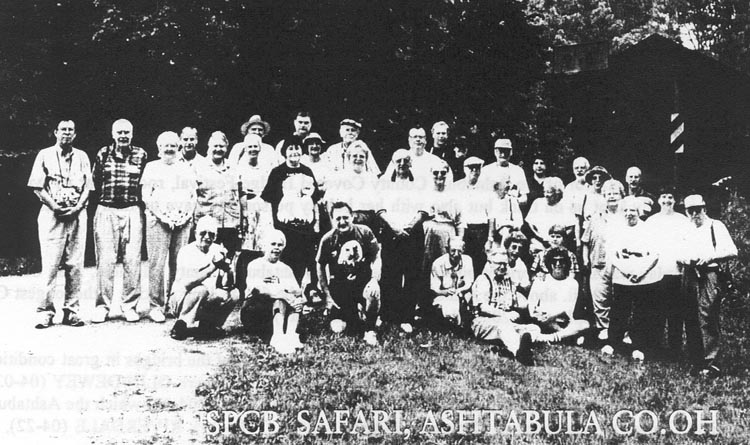
If you want a copy of the 2000 Safari group photo, shown above, write to Gordon Trabue, 710 Whitney Ave., Louisville KY. 40215 Phone 502-368-0701. The cost of the 5 g 7 color photo is $5.00 ea.
On Sunday we passed a sign on a house in Windsor which read "John Hanson, first President
of the U.S. -check it out". Just for fun, do it! Another sight we saw was the beautiful estate of
Don King (the boxing promoter). It is enclosed in what seems like miles of white fencing and has
greenery sculpted into various animal shapes.
Having seen the remaining 4 Ashtabula
County bridges, we went back to our motel for lunch after which we said our good-byes to those
who were staying Sunday night as we were leaving. I understand that evening they were treated
to a slide show by Henry Gurley.
I was fortunate to ride with David and
Joan Topham. Since we arrived on Wednesday, we went up to Lake Erie on Thursday where we
saw lighthouses and saw the `lifting bridge" at Ashtabula do its thing to allow a sailboat to go
through. We had lunch at the Covered Bridge Pizza Parlor which was made from half of the
FORMAN/EAGLEVILLE CB (04-17) which was sold to the highest bidder for $5 and made into
two pizza parlors one in 1975, one in 1977.
The Gallers should be very satisfied at
the success of the first safari they have led. The repeaters and the first-timers all seemed to get
along well and had a nice time. I know I did, thanks to the Tophams, a great group of CB'ers, and
the friends from the No. Ohio CB Society.
Christine Elsworth
 Joe Nelson, P.O Box 267, Jericho, VT 05465-0267, jcnelson@together.net
Joe Nelson, P.O Box 267, Jericho, VT 05465-0267, jcnelson@together.netThis web site page was coded by J.C. Nelson. The content is the intellectual property of the
National Society for the Preservation of Covered Bridges, Inc. and its membership.
This file posted March 18, 2001